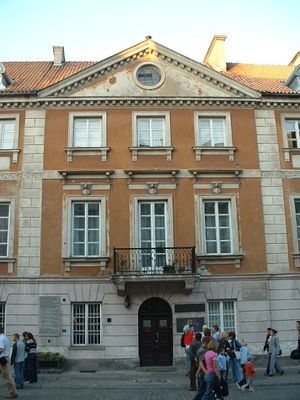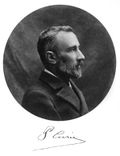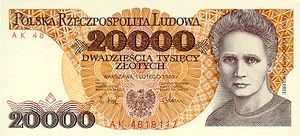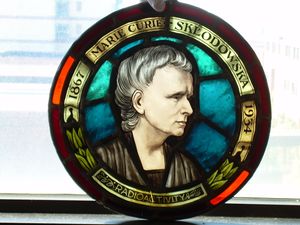ماري كوري
مارس كوري Marie Skłodowska–Curie | |
|---|---|
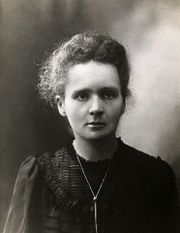 | |
| وُلِدَ | 7 نوفمبر 1867 |
| توفي | 4 يوليو 1934 (aged 66) |
| القومية | بولندا, فرنسا |
| المدرسة الأم | جامعة پاريس ESPCI |
| عـُرِف بـ | Radioactivity |
| الجوائز | جائزة نوبل في الفيزياء (1903) Davy Medal (1903) Matteucci Medal (1904) جائزة نوبل في الكيمياء (1911) |
| السيرة العلمية | |
| المجالات | فيزياء, كيمياء |
| الهيئات | جامعة پاريس |
| المشرف على الدكتوراه | Henri Becquerel |
| طلاب الدكتوراه | André-Louis Debierne Óscar Moreno Marguerite Catherine Perey |
| ملاحظات | |
The only person to win two Nobel Prizes in different science fields. | |
ماري سكاوندوڤسكا-كوري Marie Skłodowska–Curie (و. 7 نوفمبر 1867 - 4 يوليو 1934) فيزيائية وكيميائية بولندية المنشأ، فرنسية الجنسية. كانت رائدة في علم الإشعاع، الشخص الوحيد الذي حصل على جائزتي نوبل في علمين مختلفين، وأول أستاذة امرأة في جامعة پاريس. اكتشفت مع زوجها بيير كوري في باريس عام 1898م عنصري البولونيوم والراديوم.
إسمها الأصلي ماريا بولونوفسكي و بعد زواجها من الفرنسي بيير كوري غيرت إسمها إلى ماري و حملت كنية زوجة لتصبح ماري كوري و عرفت إعلامياً مدام كوري
نالت وزوجها عام 1903م جائزة نوبل في الفيزياء. وفي عام 1911م نالت مدام كوري جائزة نوبل للمرة الثانية وذلك بعد خمسة أعوام من وفاة زوجها قي حادثة طريق.
لها ابنتان ايرين و ايف. أقتفت ايرين خطى والدتها ونالت وزوجها فريدريك جوليوت في عام 1935م جائزة نوبل في الكيمياء لإكتشافهما النشاط الاشعاعي الاصطناعي.
كرم الزوجان كوري بأطلاق الوحدة (كوري) لقياس النشاط الأشعاعي وكذلك أطلاق أسم (كوريوم) على عنصر الجديد ما بعد اليورانيوم.
بيبليوگرافيا

إن عمل مارى كورى في حقل الراديوم والنشاط الإشعاعى يجعلها واحدة من عمالقة العلم الحديث. كانت ابنة لمعلم في وارسو. ولدت سنة 1867 ومنذ طفولتها أبدت ذاكرة خارقة. اضطرت للخروج إلى مضمار العمل لكى تعين الأسرة في نفقاتها ولكنها واصلت دراستها على نحو خصوصى بعد تركها المدرسة.
وسرعان ما تجلت استقلالية روحها في ارتباطها بحركة البولنديين الوطنية ممن كانوا يسعون إلى الاستقلال عن الإمبراطورية الروسية. بيد أنه على الرغم من وطنيتها المتحمسة قدر لها في باريس أن تحقق أحلامها. وهناك كانت تختلف إلى محاضرات في جامعة السوربون نهاراً وتدرس دراسة شاقة ليلاً في غرفة علوية بحى الطلبة وتعيش على وجبة من الخبز والزبد والشاى. وبعد وصولها إلى باريس بثمانية عشر عاماً عينت أول أستاذة أنثى في السوربون. ومنذ 1895 غدت حياتها وعملها مرتبطين بحياة وعمل زوجها بيير كورى ، وهو عالم بارز بدوره.
وقد قدر لها أن تتلقى أعظم أمجاد عالم العلم بما في ذلك جائزة نوبل عام 1911 لاكتشافها الراديوم والبلوتونيوم وعزلها عنصر الراديوم النقى. بيد أنه كان أيضاً مسئولاً عن موتها ففى عام 1931 ماتت بسرطان الدم من جراء التعرض للإشعاع وقد واصل عملها ابنتها وزوج ابنتها وفيما بينها لعبت أسرة كورى دوراً بارزاً في نمو علم الطبيعة الحديث عبر ستين عاماً بدءاً بدراسات التناظر البللورى وامتداداً إلى بناء المفاعلات النووية. [1]
بولندا
السوربون

جوائر نوبل
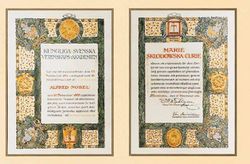
الجوائز
كان مدام كوري أول شخص يربح جائزتين نوبل
- جائزة نوبل في الفيزياء (1903)
- Davy Medal (1903)
- Matteucci Medal (1904)
- جائزة نوبل في الكيمياء (1911)
The life of even famous scientists is not luxurious. The Curies reportedly used part of their award money to replace wallpaper in their Parisian home and install modern plumbing with a bathroom.[2]
التقديرات
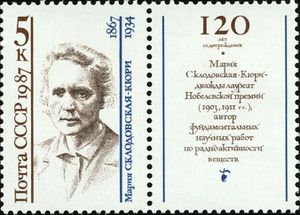
As one of the most famous female scientists to date, Marie Curie has been an icon in the scientific world and has inspired many tributes and recognitions. In 1995, she was the first woman laid to rest under the famous dome of the Paris Panthéon, alongside her husband.
The curie (symbol Ci), a unit of radioactivity, is named in her and/or Pierre's honour,[3][4] as is the element with atomic number 96 — curium.
Skłodowska-Curie's likeness appeared on the Polish late-1980s inflationary 20,000-złoty banknote. Her likeness also appeared on stamps and coins, and on the last French 500-franc note, before the franc was replaced by the euro.
Greer Garson and Walter Pidgeon starred in the 1943 U.S. Oscar-nominated film, Madame Curie, based on her life. "Marie Curie" is also the name of a character in a 1988 comedy, Young Einstein, by Yahoo Serious.
Three radioactive minerals are named after the Curies: curite, sklodowskite, and cuprosklodowskite.
Polish institutions named after Maria Skłodowska–Curie include:
- Maria Curie-Skłodowska University, in Lublin;
- Maria Skłodowska–Curie Institute of Oncology, in Warsaw.
French institutions named after Maria Skłodowska–Curie include:
- Pierre and Marie Curie University, the largest science, technology and medicine university in France, and successor institution to the faculty of science at the University of Paris, where she taught; it is named in honor of her and Pierre. The university is home to the laboratory where they discovered radium.
- The Curie Institute and Curie Museum, in Paris.
In Bayside, Queens, New York, another school named for her, Marie Curie M.S. 158, specializes in science and technology; as does Curie Metropolitan High School — located in Archer Heights, on Chicago's Southwest Side — which has a Technical, Performing Arts and IB program.
In 2007, the Pierre Curie Paris Métro station was renamed the "Pierre et Marie Curie" station.
The Maria Skłodowska-Curie Medallion, a stained-glass panel created by Jozef C. Mazur, may be found at the University at Buffalo Polish Room.
A KLM McDonnell Douglas MD-11 (registration PH-KCC) is named in her honor.[5]
انظر أيضا
- List of Poles
- List of self-inculpators
- List of people on stamps of Ireland (Marie Curie stamp, issued in 2000)
- Marie Curie Cancer Care
- Eusapia Palladino
ملاحظات
- ^ جمعية الترجمة وحوارات الثقافة
- ^ The People's Almanac, David Wallechinsky and Irving Wallace, 1975, Doubleday and Company
- ^ curie - Britannica Online Encyclopedia
- ^ Paul W. Frame. "How the Curie Came to Be". Retrieved 2008-04-30.
- ^ http://www.airliners.net/open.file/1207719/L/. Thierry Deutsch. Retrieved 2007-12-20
المصادر
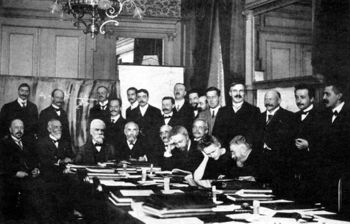
- Robert Reid, Marie Curie, New York, New American Library, 1974.
- Teresa Kaczorowska, Córka mazowieckich równin, czyli Maria Skłodowska–Curie z Mazowsza (Daughter of the Mazovian Plains: Maria Skłodowska–Curie of Mazowsze), Ciechanów, 2007.
- Wojciech A. Wierzewski, "Mazowieckie korzenie Marii" ("Maria's Mazowsze Roots"), Gwiazda Polarna (The Pole Star), a Polish-American biweekly, no. 13, 21 June 2008, pp. 16–17.
- L. Pearce Williams, "Curie, Pierre and Marie," Encyclopedia Americana, Danbury, Connecticut, Grolier, Inc., 1986, vol. 8, pp. 331–32.
- Barbara Goldsmith, Obsessive Genius: The Inner World of Marie Curie, New York, W.W. Norton, 2005, ISBN 0-393-05137-4.
- Naomi Pasachoff, Marie Curie and the Science of Radioactivity, New York, Oxford University Press, 1996, ISBN 0195092147.
- Eve Curie, Madame Curie: A Biography, translated by Vincent Sheean, Da Capo Press, 2001, ISBN 0306810387.
- Susan Quinn, Marie Curie: A Life, New York, Simon and Schuster, 1995, ISBN 0-671-67542-7.
- Françoise Giroud, Marie Curie: A Life, translated by Lydia Davis, Holmes & Meier, 1986, ASIN B000TOOU7Q.
الخيال
- Olov Enquist, Per. The Book about Blanche and Marie. ISBN 1-58567-668-3. A 2004 novel by Per Olov Enquist featuring Maria Skłodowska-Curie, neurologist Jean-Martin Charcot, and his Salpêtrière patient "Blanche" (Marie Wittman). The English translation was published in 2006.
وصلات خارجية
- Long biography at American Institute of Physics website. (Site also has a short version for kids entitled "Her story in brief!".)
- Out of the Shadows-A study of women physicists
- Marie and Pierre Curie and the Discovery of Polonium and Radium Chronology from nobelprize.org
- 1903 Nobel Prize in Physics and 1911 Nobel Prize in Chemistry - Nobel committee page; presentation speech, her award lecture etc.
- The official web page of Maria Curie Skłodowska University in Lublin, Poland in English.
- Detailed Biography at Science in Poland website; with quotes, photographs, links etc.
- Maria Skłodowska-Curie Museum in Warsaw
- Marie Curie: A Nobel Prize Pioneer at the Panthéon
- European Marie Curie Fellowships
- Marie Curie Fellowship Association
- Marie Curie Cancer Care, UK
- Marie Sklodowska Curie: Her Life as a Media Compendium
- Annotated bibliography of Marie Curie from the Alsos Digital Library
- Obituary, New York Times, 5 July 1934 Mme. Curie Is Dead; Martyr to Science
- Some places and memories related to Marie Curie
- Marie Curie on the 500 French Franc and 20000 old Polish zloty banknotes.
- American Institute of Physics: Marie Curie Exhibit on the Life of Marie Curie. Marie Curie photos available from AIP
- Marie Curie في قاعدة بيانات الأفلام الإنترنتية - Animated biography of Marie Curie on DVD from an animated series of world and American history - Animated Hero Classics distributed by Nest Learning.
- Marie Curie - More than Meets the Eye في قاعدة بيانات الأفلام الإنترنتية - Live Action portrayal of Marie Curie on DVD from the Inventors Series produced by Devine Entertainment.
- Marie Curie في قاعدة بيانات الأفلام الإنترنتية - Portrayal of Marie Curie in a television mini series produced by the British Broadcasting Corporation
- Works by or about ماري كوري in libraries (WorldCat catalog)
- Articles with hatnote templates targeting a nonexistent page
- Pages using infobox scientist with unknown parameters
- مواليد 1867
- وفيات 1934
- مدفونون في الپانثيون
- مكتشفوا عناصر كيميائية
- فيزيائيون تجريبيون
- كيميائيون فرنسيون
- فيزيائيون فرنسيون
- وفيات بسرطان الدم
- خريجو جامعة پاريس
- طاقم تدريس جامعة باريس
- حائزو جائزة نوبل في الكيمياء
- حائزو جائزة نوبل في الفيزياء
- حائزو جائزة نوبل فرنسيون
- حائزو جائزة نوبل پولنديون
- حائزات جائزة نوبل
- أشخاص من وارسو
- كيميائيون بولنديون
- فيزيائيون بولنديون
- فرنسيون من أصول بولندية
- نشاط إشعاعي
- نساء كيميائيات
- نساء فيزيائيات
- موتى بالسرطان في فرنسا

